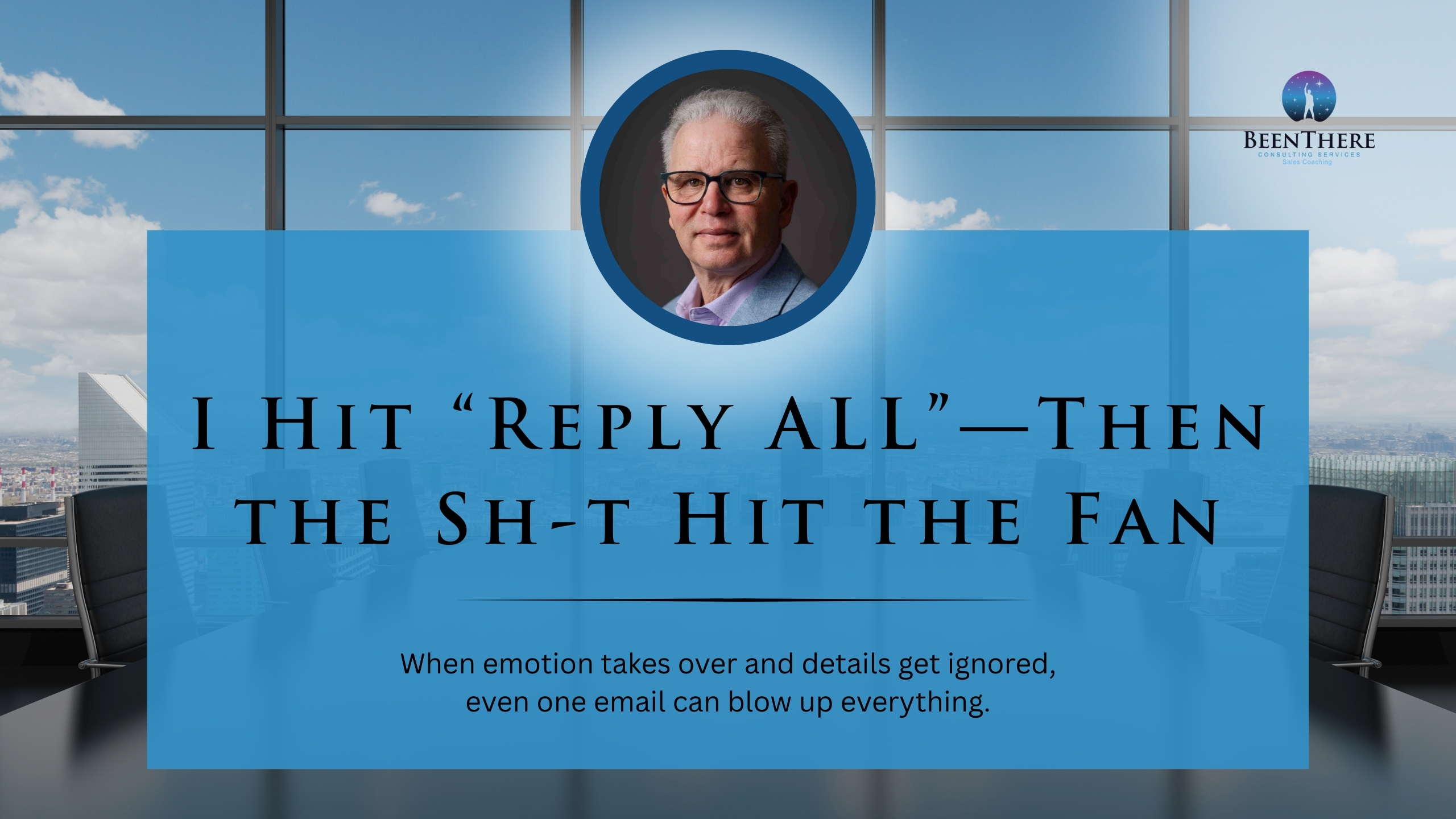When emotion takes over and details get ignored, even one email can blow up
everything.
By Phil Whitebloom, Founder of BeenThere Consulting Services
Have you ever hit “send” on an email or text… and immediately wished you hadn’t?
I have—more than once. Sometimes it’s a simple typo or grammar slip. Other times, autocorrect decides it knows better and rewrites your message into something awkward—or completely wrong. Then there are translation mishaps. I once had a North American client who was in France and emailed me—in French—to let me know he’d be stopping by our office there to pick up a product. When I ran his message through a translation program, it came out in English as: “I am going to kidnap you this afternoon.” I called the office—just in case.
But those aren’t the mistakes that leave lasting damage.
Today, I’m sharing one that did. It was costly. It was preventable. And it taught me a lesson I’ll never forget: slow down, and review every detail—especially when your emotions are high.
The Mistake That Still Stings
I was working at Sony at the time, serving as the National Sales Manager for Government and Education Sales. One of my salespeople had been working on a large opportunity—about 1,000 displays being considered for a government facility through a systems integrator reseller.
The reseller had been difficult from the beginning. He continually pressed for deeper discounts, despite the fact that we had already provided the absolute lowest pricing we could. His requests were less about negotiation and more about persistence wearing everyone down.
One day, my salesperson forwarded yet another email from the reseller—this time with an additional demand for an even lower price. I was fed up.
Without thinking twice, I replied to the email, expressing exactly how I felt—not just about the reseller’s behavior, but about the reseller himself. I was angry, frustrated, and I let it show in my words. It was a direct and emotional response.
Then I hit “Reply All.”
Only after sending it did I realize the reseller had been included in the original distribution list.
He received my message. And he read every word.
You might be thinking, “That would never happen to me.”
That’s what I thought, too.
The fallout was immediate. The reseller went ballistic, threatening to escalate the situation by calling the head of Sony in Japan to report me. I didn’t make excuses. I took responsibility, reached out to him to apologize, and tried to make it right. That didn’t go anywhere.
I also contacted Sony Japan and informed them directly: if they received a complaint about the email, it was accurate—I had written it.
I never heard anything further.
The deal ultimately fell apart. We didn’t get the business. Neither did that reseller.
This happened back in the 1990s. And while it was painful at the time, it became one of the many real-world experiences that shaped how I lead, coach, and communicate today. My decades of sales leadership—and the hard-earned lessons that came with it—are the foundation of the coaching I provide now. I make sure my clients benefit from my experiences so they can perform at the highest level without making the same costly mistakes.
Lessons in Written Communication
If you’ve ever typed out a message while frustrated, distracted, or under pressure… you already know how easy it is to misfire.
The good news? These kinds of mistakes are preventable—with the right habits in place.
Here are a few of mine that have stood the test of time:
- Don’t populate the “To” line until you’re ready to send. This one habit can prevent accidental sends—and save your reputation.
- Avoid typing in ALL CAPS. It’s perceived as shouting. Even if you don’t mean it that way, your reader will.
- Lead with the purpose. If there’s an action item, make it the first thing they see. Put the supporting details afterward so your message gets read—and acted on.
- Keep it concise. Long-winded emails get skimmed. Short, focused messages get answered.
- Save the essays for email—not text. (My opinion.) Text messages should be short, purposeful, and easy to read.
They may sound simple, but these practices can help your team communicate clearly,
professionally, and in ways that protect relationships instead of jeopardizing them.
Why This Matters—and Why You Should Work With Me
You can have great products, great pricing, and a great strategy…
But if your team doesn’t know how to communicate professionally—especially under
pressure—you will lose deals.
It’s not just about what they say.
It’s about how they say it.
When they say it.
And how it lands with the person reading or hearing it.
Imagine what would change if every member of your sales team communicated with calm, confidence, and clarity—even in stressful situations. How many deals could be saved? How many relationships could be strengthened?
That’s what I coach.
Yes, I help salespeople close more deals—but I also train them to be composed, credible, and trusted communicators. I help them avoid the landmines most don’t even see coming.
Because let’s face it:
In sales, there’s no “unsend” button.
There’s only what you say—and what your client believes you meant.
If you want your sales team to lead with trust, improve results, and be proud of how they sell, let’s talk.
 Email me at Phil@BeenThereCS.com
Email me at Phil@BeenThereCS.com
 Visit BeenThereCS.com
Visit BeenThereCS.com
 Or schedule a 15-minute conversation here to explore how I can help.
Or schedule a 15-minute conversation here to explore how I can help.


Unlock the Secrets to Closing More Sales with “Handling Objections: Clues for Closing the Sale”
Are you tired of hearing “no” or struggling to close the deal? In Phil Whitebloom’s book, you’ll learn how to turn objections into golden opportunities to secure the sale. Whether you’re new to sales or have years of experience, this book is packed with actionable insights that will elevate your approach to closing deals.
Here’s what others are saying:
Kelley Ridings says, “This book is a valuable resource! It opened my eyes to the psychology and problem-solving involved in sales. If you need to understand sales better, this is the book for you!”
Richard O., a successful small business owner for 35+ years, calls the book “a breath of fresh air” and says it’s packed with useful ideas for closing deals.
Brianna Hendley points out, “An objection is not a NO. It’s an opportunity to ask more questions and uncover your client’s true needs. A fun and impactful book I refer back to regularly.”
David Illig reminds us that everyone is a salesman in life, “Whether it’s a product, an opinion, or a point of view, Phil Whitebloom will guide you to a successful conclusion.”
Bryan Lilly describes the book as “a good tour of ideas and examples” that help you navigate different objections with key principles.
M.J. James highlights, “If you’re in a sales slump, this book will teach you how to embrace objections and turn them into catalysts for closing more deals.”
Don’t wait—level up your sales game and turn those “no’s” into “yes’s.” Get “Handling Objections: Clues for Closing the Sale” now and take the first step toward mastering the art of closing deals.
Purchase here.
PURCHASE YOUR COPY BY CLICKING HERE!
The BeenThere/SoldThat Podcast
Join Brianna Hendley of Achievant Business Coaching and Phil Whitebloom as they discuss practical strategies to enhance your sales and business skills. Get ready to achieve your goals and dreams! Listen here.
More from BeenThere SoldThat
Want to know what programs you can participate in to grow your sales and business? Go to BeenThereSoldThat.com and see what programs are available.


